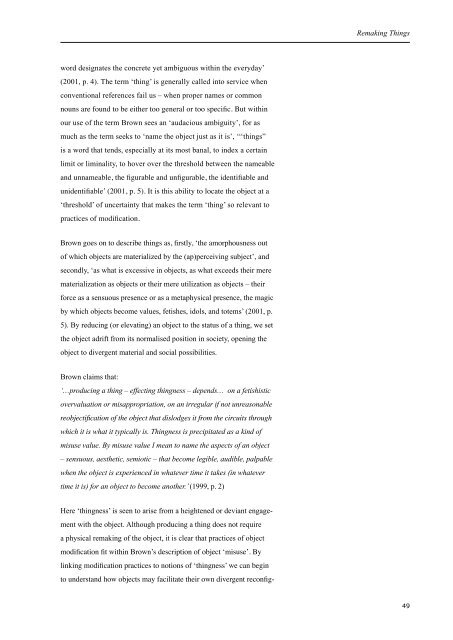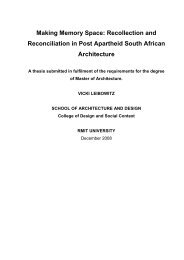Objects in Flux - RMIT Research Repository - RMIT University
Objects in Flux - RMIT Research Repository - RMIT University
Objects in Flux - RMIT Research Repository - RMIT University
You also want an ePaper? Increase the reach of your titles
YUMPU automatically turns print PDFs into web optimized ePapers that Google loves.
word designates the concrete yet ambiguous with<strong>in</strong> the everyday’<br />
(2001, p. 4). The term ‘th<strong>in</strong>g’ is generally called <strong>in</strong>to service when<br />
conventional references fail us – when proper names or common<br />
nouns are found to be either too general or too specific. But with<strong>in</strong><br />
our use of the term Brown sees an ‘audacious ambiguity’, for as<br />
much as the term seeks to ‘name the object just as it is’, ‘‘‘th<strong>in</strong>gs”<br />
is a word that tends, especially at its most banal, to <strong>in</strong>dex a certa<strong>in</strong><br />
limit or lim<strong>in</strong>ality, to hover over the threshold between the nameable<br />
and unnameable, the figurable and unfigurable, the identifiable and<br />
unidentifiable’ (2001, p. 5). It is this ability to locate the object at a<br />
‘threshold’ of uncerta<strong>in</strong>ty that makes the term ‘th<strong>in</strong>g’ so relevant to<br />
practices of modification.<br />
Brown goes on to describe th<strong>in</strong>gs as, firstly, ‘the amorphousness out<br />
of which objects are materialized by the (ap)perceiv<strong>in</strong>g subject’, and<br />
secondly, ‘as what is excessive <strong>in</strong> objects, as what exceeds their mere<br />
materialization as objects or their mere utilization as objects – their<br />
force as a sensuous presence or as a metaphysical presence, the magic<br />
by which objects become values, fetishes, idols, and totems’ (2001, p.<br />
5). By reduc<strong>in</strong>g (or elevat<strong>in</strong>g) an object to the status of a th<strong>in</strong>g, we set<br />
the object adrift from its normalised position <strong>in</strong> society, open<strong>in</strong>g the<br />
object to divergent material and social possibilities.<br />
Brown claims that:<br />
‘…produc<strong>in</strong>g a th<strong>in</strong>g – effect<strong>in</strong>g th<strong>in</strong>gness – depends… on a fetishistic<br />
overvaluation or misappropriation, on an irregular if not unreasonable<br />
reobjectification of the object that dislodges it from the circuits through<br />
which it is what it typically is. Th<strong>in</strong>gness is precipitated as a k<strong>in</strong>d of<br />
misuse value. By misuse value I mean to name the aspects of an object<br />
– sensuous, aesthetic, semiotic – that become legible, audible, palpable<br />
when the object is experienced <strong>in</strong> whatever time it takes (<strong>in</strong> whatever<br />
time it is) for an object to become another.’ (1999, p. 2)<br />
Here ‘th<strong>in</strong>gness’ is seen to arise from a heightened or deviant engagement<br />
with the object. Although produc<strong>in</strong>g a th<strong>in</strong>g does not require<br />
a physical remak<strong>in</strong>g of the object, it is clear that practices of object<br />
modification fit with<strong>in</strong> Brown’s description of object ‘misuse’. By<br />
l<strong>in</strong>k<strong>in</strong>g modification practices to notions of ‘th<strong>in</strong>gness’ we can beg<strong>in</strong><br />
to understand how objects may facilitate their own divergent reconfig-<br />
Remak<strong>in</strong>g Th<strong>in</strong>gs<br />
49
















